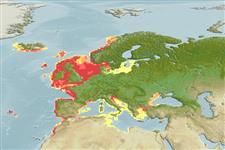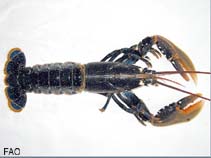Homarus gammarus (Linnaeus, 1758)
European lobster| Native range | All suitable habitat | Point map | Year 2050 |

|
| This map was computer-generated and has not yet been reviewed. |
| Homarus gammarus AquaMaps Data sources: GBIF OBIS |
Classification / Names Common names | Synonyms | CoL | ITIS | WoRMS
Malacostraca | Decapoda | Nephropidae
Environment: milieu / climate zone / depth range / distribution range Ecology
Benthic; depth range 0 - 150 m (Ref. 4), usually ? - 50 m (Ref. 4). Subtropical, preferred 12°C (Ref. 107945); 69°N - 29°N, 28°W - 32°E (Ref. 4)
Distribution Countries | FAO areas | Ecosystems | Occurrences | Introductions
Eastern Atlantic, Mediterranean and Black Sea. Not in east of Crete and in the Baltic Sea.
Length at first maturity / Size / Weight / Age
Maturity: Lm 8.9, range 8 - 8.3 cm Max length : 65.0 cm TL male/unsexed; (Ref. 441); common length : 40.0 cm TL male/unsexed; (Ref. 441); max. published weight: 6.0 kg (Ref. 4); max. reported age: 72 years (Ref. 81081)
Common total length: 23 to 50 cm. Occurs on the continental shelf at depths of 0 to 150 m, usually not deeper than 50 m. Found on hard substrates such as rock or hard mud. Nocturnal and territorial living in holes or crevices. Females with eggs are usually found throughout the year. The eggs are laid around July and carried for 10 to 11 months (Ref. 4). Indiscriminate scavengers, omnivorous or carnivorous. Feeds primarily on malacostracan crustaceans, gastropod mollusks, and polychaete annelids; but diet known to include carrion, echinoderms, lamellibranchs and plant matter (Ref. 96319).
Life cycle and mating behavior Maturity | Reproduction | Spawning | Eggs | Fecundity | Larvae
Females with eggs are usually found throughout the year. The eggs are laid around July and carried for 10 to 11 months (Ref. 4). Coupling occurs a few days after the female molts (Ref. 80921).
Main reference
References | Coordinator | Collaborators
Holthuis, L.B. 1991. (Ref. 4)
IUCN Red List Status (Ref. 130435)
Least Concern (LC) ; Date assessed: 05 December 2009
CITES status (Ref. 108899)
Not Evaluated
CMS (Ref. 116361)
Not Evaluated
Threat to humans
Human uses
Fisheries: highly commercial; aquaculture: experimental
FAO - Fisheries: landings, species profile | FishSource | Sea Around Us
Tools
More information
Internet sources
BHL | BOLD Systems | CISTI | DiscoverLife | FAO(Fisheries: species profile; publication : search) | Fishipedia | GenBank (genome, nucleotide) | GloBI | Gomexsi | Google Books | Google Scholar | Google | PubMed | Tree of Life | Wikipedia (Go, Search) | Zoological Record
Estimates based on models
Preferred temperature
(Ref. 115969): 7.7 - 13.3, mean 10.4 (based on 494 cells).
Resilience
(Ref. 69278):
High, minimum population doubling time less than 15 months (K=0.79-1.0; Fec=13,000).
Prior r = 0.37, 95% CL = 0.25 - 0.56, Based on 1 data-limited stock assessment.
Nutrients: Calcium = 109 [35, 184] mg/100g; Iron = 1.59 [1.21, 1.97] mg/100g; Protein = 20.2 [19.2, 21.3] %; Omega3 = 0.285 [0.185, 0.386] g/100g; Selenium = 48.3 [-31.7, 128.3] μg/100g; VitaminA = 0 μg/100g; Zinc = 1.79 [1.17, 2.40] mg/100g (wet weight).



